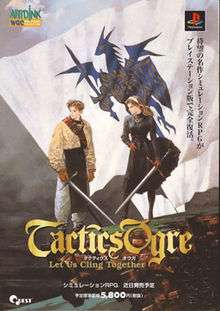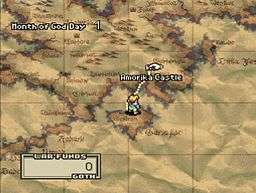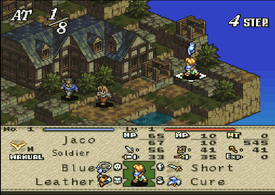Tactics Ogre: Let Us Cling Together
| Tactics Ogre: Let Us Cling Together | |
|---|---|
 Japanese PlayStation cover by Hiroshi Minagawa. | |
| Developer(s) |
Quest Square Enix (PSP) |
| Publisher(s) |
Quest (Super Famicom) Riverhillsoft (Saturn)[1] Atlus (PlayStation) Square Enix (PSP, VC) |
| Director(s) |
Yasumi Matsuno Hiroshi Minagawa (PSP) |
| Designer(s) | Yasumi Matsuno |
| Artist(s) |
Hiroshi Minagawa Akihiko Yoshida Tsubasa Masao (PSP) |
| Writer(s) | Yasumi Matsuno |
| Composer(s) |
Hitoshi Sakimoto Masaharu Iwata |
| Platform(s) |
Super Famicom Sega Saturn PlayStation Wii (Virtual Console) PlayStation Portable Wii U (Virtual Console) |
| Release date(s) | |
| Genre(s) | Tactical RPG |
| Mode(s) | Single player |
Tactics Ogre: Let Us Cling Together (タクティクスオウガ Takutikusu Ōga) is a Japanese tactical role-playing game created by Quest. The game was originally released in 1995 on the Super Famicom in Japan and then re-released on the Sega Saturn in 1996 and the PlayStation in 1997.[4] An enhanced port of the game developed by the original development team was released on February 15, 2011 for the PSP. In some regions, notably Japan, the remake was retitled as Tactics Ogre: Wheel of Fate.
Though Let Us Cling Together is the second entry released in the Ogre Battle franchise, it featured dramatically different gameplay than its predecessor. While Ogre Battle: The March of the Black Queen was more akin to a grand strategy RPG, Let Us Cling Together was a more intimate squad-based isometric tactical RPG. Let Us Cling Together, then, launched a sub-series within the franchise with Tactics Ogre being used to distinguish the two forms of gameplay in later sequels (notably Tactics Ogre: The Knight of Lodis).
Story

Chronologically, it is the 7th episode of the Ogre Saga. For eighty years, Valeria has been in constant strife, and its three leading ethnic groups all claim leadership. King Rodrick, aided by the forbidden powers of the "Palace of the Dead," is able to dominate the people of Valeria until Dorgalua of Bakram successfully leads his army to defeat Rodrick. Dorgalua then claimed the throne as his own, and was able to end the struggle between the ethnic groups. Under King Dorgalua, the rights of the people were preserved, and all internal struggles in Valeria came to a temporary halt.
All is right until the entire royal family is lost due to a string of accidents. Because the late King Dorgalua had no living heirs, the ethnic groups once again struggled for leadership: Abuna Brantyn of the royal court, Heirophant Balbatos of the Galgastani, and Duke Ronwey of the Walister all fought for control, but in the end, Balbatos and Brantyn stalemated. In order to preserve their power, the two men took separate measures: Heirophant Balbatos sought an ethnic cleansing policy and slaughtered thousands of innocent Walister and Galgastani, while Brantyn received aid from foreigners, the Dark Knights Loslorien of the Holy Lodis Empire.
Denam Pavel is the primary protagonist in Tactics Ogre. He is the son of Abuna Prancet, and after Prancet was taken away by the Dark Knights and his home town was massacred, Denam, his sister Catiua, and his friend Vyce plan a vendetta against the Dark Knights. He must lead the "Liberation Army" to bring freedom to the oppressed nation of Valeria.[5]
Gameplay

The gameplay of Tactics Ogre is similar to the turn-based strategy style of tactical RPGs. Like other tactical RPGs, the player builds up a team of several characters with changeable classes and fights battles on isometric grids.[6] The order of movement is determined by the speed of individual characters, in contrast to games in which each side moves its entire team at once. Each character is moved individually on the grid and the order of combat is calculated for each character individually.[6][7]
The gameplay is intermixed with expositional cutscenes revealing the plot, shown in the same isometric view as the battles. Movement and team management between battles are done through a map interface. Most human characters begin as either amazons or soldiers. By leveling up correctly, they can later progress to the other male or female classes, although most advanced classes are limited to certain alignments: lawful, neutral, or chaotic. Another feature is the "Warren Report",[7] a type of database on the land, people, encounters and races of Valeria.[8]
Development
This was the second game directed by Yasumi Matsuno, following Ogre Battle, which featured a considerably different game style. Conceived as the seventh episode in the Ogre Battle Saga, the game was originally titled Lancelot: Somebody to Love, and then Tactics Ogre: The Bequest of King Dorgalha, before the final title was settled upon. According to Matsuno, Japanese players were not used to the real-time strategy gameplay of Ogre Battle so he changed to a turn based grid system for Tactics Ogre. Furthermore, he stated he felt the previous game "lacked reality", with too many gods and demons, and thus decided to switch to a more dark fantasy atmosphere with a Middle Ages/Roman Empire base for a more realistic setting.[9]
The game was innovative in its nonlinear branching plotline inspired by sound novels and gamebooks at the time.[9] Crucial decisions made in the game determine the path of the story, the members of your army and the ending sequence. There are multiple endings with radically different outcomes. The game expanded the non-linear alignment system of its predecessor, with three types of alignments for each unit: Lawful, Neutral, and Chaos, none of which are portrayed as necessarily good or bad. The game gives players the freedom to choose their own destiny, with difficult moral decisions, such as whether to follow a Lawful path by upholding the oath of loyalty, even if it means slaughtering civilian non-player characters on the leader's command), or follow the chaotic path by following a personal sense of justice, even if it means rebelling.[6][7] Such factors affect the game's ending, which is also affected by decisions such as whether to obtain the most powerful class, which can only be acquired by making a tragic sacrifice.[7]
While the concept of branching storylines affected by Law/Neutral/Chaos alignments had already been explored before in the Megami Tensei series developed by Atlus, Tactics Ogre presented choices more grounded in reality, revolving around war crimes and political alliances, rather than supernatural elements.[10] The dark, complex, political narrative of Tactics Ogre revolving around the reality of war was inspired by Matsuno's outside perspective on events that unfolded during the Yugoslav Wars in the early 1990s, including the Bosnian Genocide.[11]
The subtitle of Let Us Cling Together is a reference to the Queen song "Teo Torriatte (Let Us Cling Together)" from their album A Day at the Races. This is one of many references to Queen songs in the series, including Ogre Battle: March of the Black Queen, which references "Ogre Battle" and "The March of the Black Queen" from the album Queen II.
Soundtrack
| Tactics Ogre: Let Us Cling Together | |
|---|---|
| Soundtrack album by Hitoshi Sakimoto, Masaharu Iwata | |
| Released | 1995 |
| Genre | Video game music |
| Label | DataM/Polystar |
| Tactics Ogre: Let Us Cling Together track listing[12] | ||
|---|---|---|
|
Orchestral disk
|
Orchestral disk
|
Versions and ports
Super Famicom
The original version of the game was released in 1995 for the Super Famicom, the Japanese counterpart of the Super Nintendo Entertainment System. In 2010, a fan translation was released for the game, extracting the English script from the official PlayStation localized port.[13]
Sega Saturn
Tactics Ogre was ported to the Sega Saturn only in Japan in 1996. This version has voice acting in most of the important scenes, and an art gallery exclusive to this version.[14] In addition, this version makes it is possible for the player to swap bodies with some normally restricted classes through one ability from the Ogre Blade item.[14] In all of the other ports of Tactics Ogre, restrictions are made on which character can be controlled under this ability, but the Sega Saturn port does away with any restriction, significantly impacting gameplay if this feature is to be used by the players.[15]
Playstation
The PlayStation version of the game has remixed SNES music and thereby does not take full advantage of the system's audio capabilities.[16] Due to the limited release of this game and the reluctance of its owners to sell it, the game tends to be hard to find. Used copies of the PlayStation version routinely sell for more than $80.[17]
PSP remake
Despite officially resigning from Square-Enix before the completion of Final Fantasy XII, Matsuno returned for the re-development of Tactics Ogre: Let Us Cling Together for the PSP. Matsuno worked on the port along with the game's original staff.[18] In the PSP version, "The World" system allows players to revisit key plot points and make different choices to see how the story unfolds differently.[19] It was released on November 11, 2010 in Japan.
Reception
| Reception | ||||||||||||||||||||||||||||||||||
|---|---|---|---|---|---|---|---|---|---|---|---|---|---|---|---|---|---|---|---|---|---|---|---|---|---|---|---|---|---|---|---|---|---|---|
| ||||||||||||||||||||||||||||||||||
| ||||||||||||||||||||||||||||||||||
In March 2006, the Japanese Famitsu magazine readers voted on their 100 all-time favorite games, and Tactics Ogre was named number seven.[36]
GameSpot deemed it "a blast from the past for just about everyone." Comparing it to Final Fantasy Tactics, GameSpot says "Aesthetics aside, however, Tactics Ogre is purer and more playable than its hi-tech descendant and definitely worth a look from strategy/RPG enthusiasts."[5] RPGamer echoed that sentiment, stating "the core of this game's epic story and groundbreaking gameplay are timeless, emblematic reminders that the game is and forever will be a masterpiece. The original is always the best."[30]
The music of the game was popular among fans of the series. RPGFan stated in its review of the soundtrack that "As I have never played any of the games in this series, nor particularly been a fan of strategy games, the true power of this soundtrack is perhaps lost on me. But what I can say is that what it does, it does well, and it doesn't need any live instruments to do it, either. This one is recommended if you're a fan of the series or a fan of orchestral game music from those days of old."[12]
The PSP port has received positive reviews, with an average aggregate rating of 88% at GameRankings,[21] 87 out of 100 at Metacritic.[22] with reviewers praising the gameplay, storyline, and changes to the leveling system as well as the World and Chariot systems.
References
- 1 2 "Sega of Japan Saturn Third Party Master of List for 1996". Retrieved 14 Sep 2011.
- ↑ Tactics Ogre: Let Us Cling Together Hits PSP February 15th - PlayStation Blog
- ↑ "Square Enix Announces Solid Spring 2011 Line-Up For PSP". GamingUnion.net. 2010-11-07. Retrieved 2010-11-07.
- ↑ "Retro Review of Tactics Ogre," Game Informer 174 (October 2007): 134.
- 1 2 3 Bartholow, Peter (1998-05-14). "Tactics Ogre for PlayStation Review". GameSpot. Retrieved 2006-12-05.
- 1 2 3 Parish, Jeremy. "PlayStation Tactics". 1UP.com. Retrieved 2010-02-04.
- 1 2 3 4 Silverwolf X. "Tactics Ogre Review". RPGFan. Retrieved 2006-12-05.
- 1 2 Jason Nimer. "Tactics Ogre: Let Us Cling Together - Review". The Gamers' Temple. Retrieved 2011-04-02.
- 1 2 http://www.4gamer.net/games/116/G011621/20110426090/
- ↑ Jeremy Parish, Let Us Remember Together: A Tactics Ogre Retrospective (Page 2), 1UP, February 8, 2011
- ↑ Jeremy Parish, Let Us Remember Together: A Tactics Ogre Retrospective, 1UP, February 8, 2011
- 1 2 Strange, Derek. "RPGFan Soundtracks - Tactics Ogre ~ Let Us Cling Together:". RPGFan. Retrieved 2006-12-09.
- ↑ AGTP
- 1 2 GameFAQs.com
- ↑ HG101.com
- ↑ Jnk2k2. "Tactics Ogre: Let Us Cling Together review". netjak. Retrieved 2006-12-09.
- ↑ "VideoGamePriceCharts.com". Retrieved 2008-04-15.
- ↑ Cunningham, Michael (2010-07-21). "Tactics Ogre Remake Revives Matsuno". Retrieved 2010-07-22.
- 1 2 Tactics Ogre: Let Us Cling Together, GamesRadar, February 15, 2011
- ↑ "Tactics Ogre for PlayStation". GameRankings. CBS Interactive. Retrieved 1 November 2014.
- 1 2 Tactics Ogre: Let Us Cling Together, GameRankings, accessed 2011-02-18
- 1 2 Tactics Ogre: Let Us Cling Together, Metacritic, accessed 2011-02-18
- ↑ Tactics Ogre: Let Us Cling Together Review, 1UP, February 9, 2011
- ↑ Tactics Ogre: Let Us Cling Together, Game Informer, February 8, 2011
- ↑ Heidi Kemps, Tactics Ogre: Let Us Cling Together, GamePro, February 15, 2011
- ↑ Tactics Ogre: Let Us Cling Together Review, GameSpot, February 12, 2011
- ↑ Tactics Ogre: Let Us Cling Together Review - Let us cling to this game, IGN, February 7, 2011
- ↑ Tactics Ogre: Let Us Cling Together - Reviews, GameRankings, accessed 2011-02-15
- ↑ Tactics Ogre: Let Us Cling Together Review, Cheat Code Central, accessed 2011-02-18
- 1 2 Boulette, Bryan. "Tactics Ogre - Staff Retroview". RPGamer. Retrieved 2006-12-05.
- ↑ Alex Toran. "Tactics Ogre". RPGFan. Retrieved 2011-02-18.
- ↑ "Developers' Games of 2011". Eurogamer. 2 January 2012. Retrieved 7 January 2012.
- ↑ Dietz, Jason (December 23, 2011). "The Best Videogames of 2011 (PC)". Metacritic. Retrieved 10 January 2012.
- ↑ "Best Graphic Adventure of 2011: Professor Layton and the Last Specter (Nintendo DS)". Games of the Year 2011. RPGFan. 2011. Retrieved 26 January 2012.
- ↑ "GameSpot's Best of 2011 Special Achievements". GameSpot. 30 December 2011. Retrieved 31 December 2011.
- ↑ Campbell, Colin (2006-03-03). "Japan Votes on All Time Top 100". Next Generation. Retrieved 2005-12-05.
External links
- Official Tactics Ogre: Wheel of Fate website (Japanese)
- Official Tactics Ogre: Let Us Cling Together website (English)
- Tactics Ogre at MobyGames
- Tactics Ogre: Let Us Cling Together Tactics Ogre fansite
- Tactics Ogre: Let Us Cling Together Tactics Ogre (PSP) Guides
- Every Ending and its Variations at VGMuseum
- Reviews